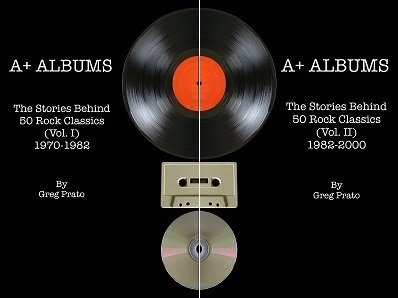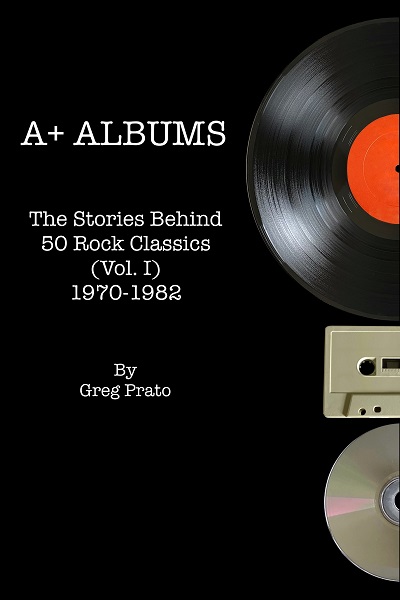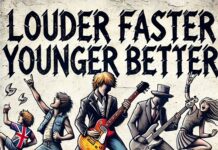Just in time for the holiday season of 2022 comes not one, but two new books by yours truly, A+ Albums: The Stories Behind 50 Rock Classics (Vol. I), 1970-1982; plus 50 more for A+ Albums: The Stories Behind 50 Rock Classics (Vol. II), 1982-2000. What can you expect from both? An excerpt from Vol. I (in which the Eagles’ 1976 classic album, Hotel California is analyzed) will give you a taste.
Hotel California
(Eagles, 1976)
1976 was quite a year for the Eagles. In that year alone, they issued two albums that at the time of this book’s release are #2 and #3 of the best-selling US rock albums of all time – Their Greatest Hits (1971-1975) at 41.2 million and Hotel California at 21.8 million (and in case you were wondering, Thriller is numero uno, at a cool 50.2 million).
Originally formed in 1971 in Los Angeles, band members would come and go, with singer/guitarist Glenn Frey and singer/drummer Don Henley being the chief songwriters/mainstays — before the “Hotel California line-up” was solidified in 1975 with guitarists Don Felder and Joe Walsh, plus bassist Randy Meisner. But from their formation to the point of writing the material for what would become Hotel California, a slight stylistic shift had occurred, as Felder explained in The Yacht Rock Book.
“When I first heard the Eagles, it was definitely ‘country rock.’ And it was more focused on country than on rock. When I joined the band, it was my objective – at the behest of both Glenn and Don — to shift from a country feel into more of a rock/R&B feel. That was sort of why I was brought into the band in the first place. And then I do know quite a few people that have their large yachts, and I don’t know if it was because I was in attendance or aboard their vessel or the fact that they just liked that music, but I have heard the Eagles’ music on a lot of yachts! Not only on the ones I was on, but echoing through the harbors from somebody having a party. I would say the Eagles’ music was all three — country rock, soft rock, and yacht rock.”
Working once again with producer Bill Szymczyk, the sessions for their fifth studio album overall lasted from March through October 1976, at two studios — Criteria (in Miami) and Record Plant (in Los Angeles). And prior to entering the studio, Felder had demoed several tunes for consideration — with one just happening to be one of the most celebrated and instantly recognizable rock tunes of all-time, which would serve as the album’s opener. “I had rented a house on the beach in Malibu,” Felder also recalled in The Yacht Rock Book. “I think it was ‘74, ‘75 — and was just sitting on a couch on a beautiful July or August day, with my young kids playing in the sand on a little swing set, out front on the beach. The beautiful Southern Pacific was sparkling with Southern California sunlight. I was sitting on the couch, playing guitar, and out rolled that original progression. So I played it four/five/six times so I would remember it, and in my back bedroom of this rented house, I set up this little four-track reel-to-reel tape recorder in my daughter’s bedroom — she was one year old at the time. When she was awake, I could go back and make these music tracks. I went back and recorded some of that progression, then just turned it off.
“Later, when we started writing songs for what was going to become the Hotel California record, I went back and started listening to a bunch of these ideas. I think I had six, eight, ten, fifteen different song ideas. I sat down and started finishing these ideas, by starting with a drum machine, playing a rhythm guitar, playing a bass on it. Pretty much building the track — almost exactly what you hear on the Eagles’ version now of ‘Hotel California,’ without a few ‘Walsh-isms.’ I was trying to write something that Joe and I could play together on the end of that song. It was like what we had been doing in Joe Walsh & Friends, before Joe joined the band. I wanted to play against him on something, so I thought that track would be a good way to give us that foundation to play on.
“So I made up this demo that had me playing kind of both parts — me and Joe — some of which Joe ended up playing in his solos and I had written on the demo. And I had to play my part exactly like I played it on the demo, because Henley wouldn’t let me play anything but what he had been listening to on the cassette. So I submitted several songs, gave it to Randy, Joe, Glenn, and Don, and said, ‘If there’s anything on these cassettes you want to finish writing, let me know, and we’ll get together and start writing.’ So, Henley called me up and said, ‘I really like that song that sounds like a Mexican reggae.’ It was the only song idea on that cassette that sounded like that as he described. I said, ‘Oh, that’s great. Let’s get together.’ He, Glenn, and I sat down and started talking about what it should be about.
“I don’t remember if it was Glenn or Don that came up with ‘Hotel California,’ but we were having this discussion about none of us being from California. We had all driven in on Route 66 at night, and you can see the lights of Los Angeles hovering on the horizon for about seventy miles away at night — if it’s a clear night coming through the desert. And when we got here, everybody was in search of that dream. And we were somehow, like a genie, rewarded with this dream, that so many of thousands — if not millions — of people have pursued here. And here we were. So we wanted to write a song about that.
“Henley, being the brilliant lyricist that he was, took that idea and wrote just stellar, picture postcard lyrics of the storyline that runs through that song. And obviously saying it like everything else he does — impeccably and superbly in tune. As soon as you hear his voice, you know exactly who it is. The whole combination of writing, lyrics, guitar playing, the production that Bill Szymczyk helped put together on the project. It was just a magical combination for that particular album. To me, it seemed like that record was sort of the crescendo — or climax — of the Eagles’ writing and production.” As a result, the tune would be credited to Felder, Henley, and Frey.
But the group’s country leanings were still on display on specific tunes – most notably on one of the album’s other best-known tunes, “New Kid in Town,” as well as “Wasted Time,” “Try and Love Again,” and “The Last Resort.” Also included were a few tunes that were symphonic and a bit shmaltzy (a reprise of “Wasted Time” and “Pretty Maids All in a Row”) — but were balanced out by two more rockers, which happened to also be amongst the LP’s strongest selections.
First of which was the riff rocker “Life in the Fast Lane” — a tune credited to Henley, Frey, and Walsh, which as its title alludes to, is about a couple who lead a wild and reckless lifestyle. And according to Felder, so was the band at the time. “I think it’s being quite polite to say ‘a lot of partying.’ I think there was massive amounts of partying, all types of levels of it. Abusing ourselves with drugs and alcohol, abusing ourselves with the level at which we were working. We had very little time off – we were always on the road or in the studio. There was a lot of women involved in the whole thing that was going on. There was a lot of partying.
“We used to have a phrase that if somebody had just gone to the bathroom and done some cocaine and had come out and you could still see white powder around their nose, it was called, ‘You’re showing.’ During the filming of that ‘Hotel California’ video, while Joe and I are playing the end of the solo, I lean over to him – jokingly – and say, ‘You’re showing.’ [Laughs] It was just a way to play with him, like, ‘Oh my God…we’re being filmed and I’ve got blow on my nose’!”
And then the other rocker being “Victim of Love.” “It was on that same reel as ‘Hotel California’ — it was another one of the demos that was on that reel,” recalls Felder. “It was probably one of the hardest rock tracks at the time that the Eagles had attempted to record. And I had played drums on a lot of the demos that I made, although I’m not a great drummer, but I had to play simple enough parts that Don could sing and play drums at the same time. If it was a complicated drumbeat, it makes it too complex to be able to sing and play drums at the same time. So, I tried to make it pretty simple drum-wise. But hard-hitting. It was one of the tracks that was on that cassette that I gave to Don, and me and Glenn and JD Souther really liked that song.
“I had written the melody pretty much for the verses – you can hear the opening guitar part is the melody for the verses. And I had a different melody for the chorus. When we got together, we sat down with Don, Glenn, and JD Souther, to re-write the lyrics for that song. And sitting around — I think it was at Glenn’s house — we were trying to think of a hook or a word or a catch or something. So JD said, ‘What about the word ‘victim’?’ And I said, ‘Ooo, I like that. That’s great. That’s a really strong word to base a song on.’ And JD said, ‘Well yeah, but…victim of what?’ And Henley said, ‘Victim of love.’ That stuck, and we were off to the races — writing lyrics that would lead you into that chorus, which was ‘Victim of Love.’ It turned out that JD, Don, and Glenn wound up writing most of the lyrics to that song — not all of the lyrics — and I wrote the music and the melody.”
Released on December 8, 1976, both the Hotel California album and its title track single would reach the top of the Billboard 200 and Hot 100, respectively — with two more singles hitting the charts, as well (“New Kid in Town” peaking at #1 and “Life in the Fast Lane” reaching #11). And as you could probably figure out with the earlier mention of it being one of the greatest selling albums ever, Hotel California came in as the #4 top-selling album of 1977, and has continued to reappear on the charts ever since.
And there is also one more item forever associated with the album — its iconic cover image of the Beverly Hills Hotel at sunset, taken by photographer David Alexander. Felder: “When they first showed me that picture of it, I went, ‘What hotel is that?’ They said, ‘The Beverly Hills Hotel on Sunset.’ I went, ‘No it’s not.’ Because from the street, it looks like about a fifteen-foot hedge — like a privacy screen. So unless you drive onto the property, you don’t even see the hotel. The only way you would get that — as it was explained to me, later – that they had rented a cherry picker and parked it across the street, and unbeknownst to the Beverly Hills Hotel, they erected this cherry picker and the photographer took a bunch of pictures right at sunset as the lights were coming on at the hotel. I think it was Kosh [aka John Kosh] that was the director of that artwork. It turned out to be — in a nutshell — the perfect image to capture the concept of Hotel California.”
“The inside cover [of the gatefold], we wanted it to be much more sleazy looking than the Beverly Hills Hotel — which is really more typical of old Spanish architecture. And yet, we wanted to staff the lobby — in this old, kind of seedy hotel, I think it was the Lido Hotel, in a pretty shady area — with people that were either guests coming in or at a party or bellmen, and make it look like a live staff shot in the middle of this hotel, that we were standing there, checking in to. Or checking out — however you wanted to read it.
“I remember doing that photo session. We took a lot of different shots and angles on that, but that one somehow wound up with what people seem to claim is some lady in one of the windows above us all — on the second story, in like an alcove or something. I don’t remember anything about the woman being up there. But if you look carefully, you can see some female figure up there — supposedly. But they were all people that we knew — it was business managers, lawyers, our makeup people, and our PR people. All the people that were part of the Eagles company and business we invited to be a part of that shoot. Now that I look back, I still recognize all the people that were involved in that shoot.”
And while the Eagles would continue to soar and score another #1 album (1979’s The Long Run), before splitting up and reuniting in 1994, Felder — and probably most Eagles fans — feels that Hotel California was the band’s peak. “The Eagles had an immense catalogue of great songs. And on every record, we tried to raise the bar to a higher level of songwriting, a higher level of recording and production, and a higher level of performance. So, every new Eagles record that came out was better than the last one. Until we finished Hotel California, and had to top that, I thought that was kind of the crescendo or the climax of the creative part of that band. It was almost like a level so high that we couldn’t get over it. As Glenn liked to say, ‘We created a monster, and it ate us.’ He had a great way of saying a very humorous catchphrase that was right on the money and very truthful.”

Both A+ Albums: The Stories Behind 50 Rock Classics (Vol. I), 1970-1982 and A+ Albums: The Stories Behind 50 Rock Classics (Vol. II), 1982-2000 are available in paperback, hardcover, and Kindle formats, and soon, both will be available in audio versions.




















